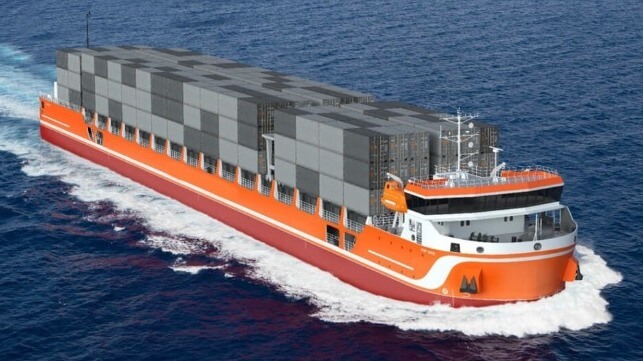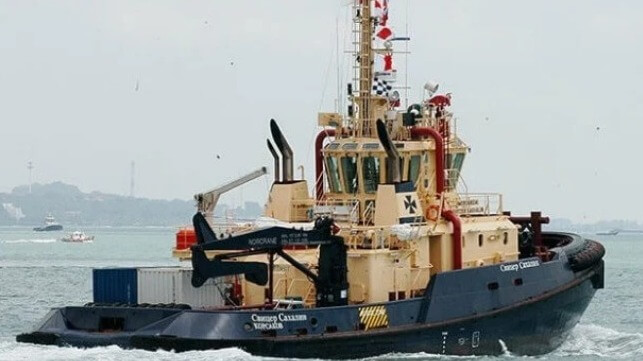Russia Starts Building Ships for North-South Trade Route to Iran

The first block for a new class of Russian domestic containership that is also capable of carrying dry bulk cargo was laid down at the Lotos Shipyard, part of the state-owned United Shipbuilding Corporation. In addition to the unique design, the shipbuilding corporation is reporting the ships will be a key contributor to Russia’s plans for the North-South International Transport Corridor and proof that Russian shipbuilding is proceeding despite the sanctions.
Construction is beginning on the first of four vessels that will be the lead to the class. The vessels measure approximately 463 feet in length and have a 55-foot beam and depth of up to approximately 20 feet giving them the maximum dimensions to transit the Volga-Don Canal. The 60-mile long waterway opened in the 1950s makes it possible to sail from Saint Petersburg to the Caspian Sea.
The design for the vessels was developed by the design bureau of USC, Vympel Design Bureau in Nizhny Novgorod, and they are saying it is unique because in addition to containers, it can carry any type of dry cargo, including grain, timber, and lumber, general cargo, in two holds. The vessels will also have a large capacity for oversized cargo. The capacity will vary between 5,000 tons for river transport, where it is limited to a draft of approximately 12 feet, and 9,200 tons for sea transport. Propulsion for the vessels will consist of two medium-speed diesel engines each with 1200 kW and two rudder propellers with a speed of up to 10 knots. There will also be two auxiliary diesel generators of 400 kW which will be enough to power 60 refrigerated containers.
According to the Ministry of Industry, Trade and Energy of the Astrakhan Region the plan is to build a total of 21 of the vessels for the North-South trade. Officials have said that at least 45 ships of the Volga-Don Max class are needed longer term for the new corridor. Each vessel is expected to cost about $22 million to build.
Officials of USC highlighted the start of the project with the keel laying on May 4 as evidence of the strength of Russian shipbuilding. The Lotos Shipyard where the vessels are being built was one of 28 subsidiaries as well as United Shipbuilding Corporation designated by the U.S. Department of State in April 2022 as being part of the Russian defense establishment. The sanctions implemented in response to the war in Ukraine prevent U.S. companies from working with, financing, or providing supplies to the sanctioned shipyards.
The new vessels are part of an agreement highlighted by Russia to build trade on the Caspian Sea. The corridor stretches some 4,500 miles and links to Iran’s railway and road system. The endpoint is the port of Bandar Abbas and from there, cargo will also be able to continue by sea to India. Branches along the route also make it possible to send cargo to Azerbaijan, Kazakhstan, and Turkmenistan.
Russian officials reported that they expect with the contribution of these new vessels trade will grow dramatically along this route. They said that 17 million tonnes move along the route currently and it will grow to 32 million tonnes by 2030.
The first of the new vessels is due to enter service in 2024. Two ships of the class will be delivered during the first year and two additional ships in 2025.
Russian Court Seizes Control of Four Tugs Owned by Maersk’s Svitzer

A Russian arbitration court in late April seized control of four tugs owned by Maersk’s Svitzer towage company and operating under a long-term contract to provide services at the Sakhalin-II oil and gas project in eastern Russia. Maersk had been seeking to end the services since the company announced plans two years ago to withdraw all operations from Russia in protest over the invasion of Ukraine.
Svitzer built four Robert Allan designed heavy-duty ice-class tugs in 2007 which were operating under charter to a Russian subsidiary Svitzer Sakhalin which in turn had an agreement with the operators of the oil and gas project to provide marine services. The contract was extended in early 2020 going into effect in November 2020 and running for an additional 10 years. At the time, Svitzer said it supported the mooring of more than 1,800 gas carriers with the four tugs and two mooring boats. Svitzer said it had 58 Russian crewmembers and nine onshore staff.
The Russian government took control of the Sakhalin-II project in August 2022 from the operating company that had been formed by Gazprom in partnership with minority investors Shell, Mitsui, and Mitsubishi. Svitzer’s service contract was transferred to the new Russian operator of the oil and gas project.
According to Russian media reports, Svitzer announced plans to transfer the four tugs out of Russia and re-registered them away from the Russian flag with Svitzer Sakhalin attempting to invoke a force majeure on April 17 to suspend the service contract. The Russian operator of the oil and gas project took Svitzer to court arguing that the loss of the four tugs could jeopardize production activities at the facilities.
Russian media outlet Kommersant reports on April 24 the court temporarily arrested the four tugs and gave control of them to a third-party company. They granted the right to continue to operate the tugs in Prigorodnoye. The stories indicate that Svitzer has the right to file an appeal till May 18 seeking to regain control of the tugs and end the service contract.
In a brief statement, Maersk said “We believe the situation regarding the tugs is untenable and efforts to resolve the matter are ongoing.” Maersk reports that all of Svitzer’s employees in Russia have resigned.
The tugs were one of Maersk’s final assets in Russia. In 2020, the company took a more than $700 million write-down on its Russian assets. It sold its interest in a terminal operator and its cold storage warehouse in Saint Petersburg and inland terminal in Novorossiysk. They had indicated that they were also looking to sell the four tugboats.
The vessels, the Svitzer Sakhalin and Svitzer Aniva, were built by ASL Shipyard of Singapore, while the Svitzer Busse and Svitzer Korsakov were built by Admiralty Shipyard in St. Petersburg, Russia. Each is 590 dwt with a length of 113 feet overall.
When the tugs were built, Allan reported they were a unique design. Diesel powered they demonstrated during trials a bollard pull of 73 tonnes and a free running speed in excess of 13.5 knots. “The unique hull form incorporates an aggressive icebreaking ‘spoon’ bow, with shallow buttock angles in the ice contact zone, optimized for icebreaking performance,” Allan said. The tender called for tugs having the capability to break 85 cm of level ice at a minimum of 3 knots, perform harbor ice management, and when operating in pairs break a channel wide enough for the tankers calling at the terminal.
No comments:
Post a Comment